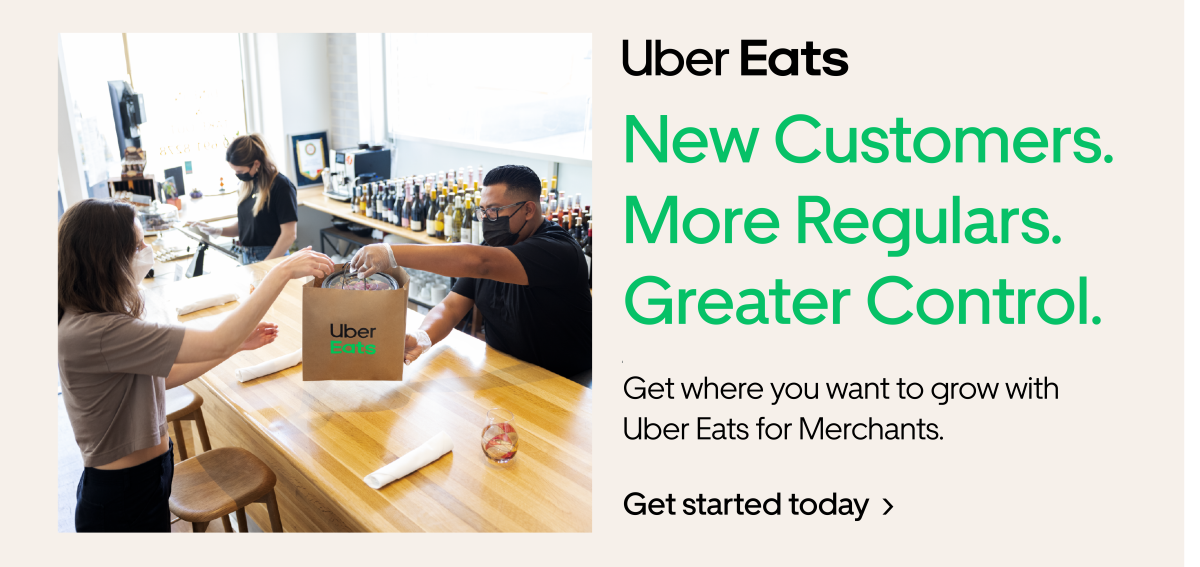

Around the globe, businesses partner with Uber Eats to grow their way – quicker than ever before. With exposure to the millions of consumers across Uber’s rides and eats apps, plus powerful marketing, order management, and fulfillment solutions, Uber helps makes it easy for you to reach more customers and increase sales.
Delivery is a QSR’s non-negotiable, but what do customers really expect?

Businesses can unlock new opportunities by staying a step ahead.
In Australia, the popularity of Online Food Delivery has soared as more people seek new ways to eat restaurant-quality food at home post-pandemic.
The Australian Online Food Delivery market is one of the most mature in the world, having grown as much as fourfold in 2018 and 2019. In 2021, Australia's Online Food Delivery market grew 30% based on a report by Edison Trends, mainly driven by COVID.
And with this growth, customer expectations have risen as well. According to Uber Eats: Restaurant Pulse Check Report, 71% of today's customers value good food the most, 52% think cleanliness should be a QSR’s top priority, 50% believe good service is the key fundamental, while 26% and 25% put speed of service and varied menu options above the rest, respectively.
New behaviours and opportunities
According to Uber Eats, more than half (55%) of the restaurants surveyed reported an increase in revenue from online food delivery platforms since November 2021.
The pandemic has caused a significant shift in customer behaviour, with many QSRs accelerating their Online Food Delivery services to satisfy customer demand. The result has been an increase in revenue and profit for those restaurants that were able to adapt quickly.
However, it's not just about putting your menu online and expecting customers to find you. In order to be successful, QSRs need to ensure they are visible on multiple delivery platforms, as well as focus on their branding and marketing to attract customers.
Beyond meeting the current trend, food delivery platforms also help QSRs expand their customer reach, enhance their discoverability, and make it easier for customers to find them.
CBRE reports that Uber Eats holds the largest share (59.7%) of the food delivery app market in Australia. Partnering with them could help a QSR increase its customer base by tapping into a large number of potential customers that already use their platform. In fact, according to Uber Eats, among restaurant owners who used online food delivery during the lockdown, an average of 35% discovered the restaurant through an app.
A step ahead of the consumer
The Australian restaurant sector’s growth rate was 27.4% in the 12 months to April 2019, compared with the same period of the previous year. Aside from the restaurant sector, growth is also expected for Online Food Delivery with 80% of restaurant owners in Australia currently using it based on the same Uber Eats survey.
The popularity of food-delivery services is expected to continue, with the size of the industry growing over the next few years, especially with the younger generation. With this trend, the number of online food delivery users in Australia is expected to amount to 9.5m users by 2027.
This surge in growth presents a unique opportunity for QSRs to get ahead of the curve and focus on providing an exceptional online food delivery experience for their customers. Whether it's through focus on quality, service, or branding, QSRs that can provide a superior online food delivery experience will be well-positioned for success in the years to come.
Final Thoughts
The success of Online Food Delivery apps and platforms is not to be underestimated. There is a trend towards a service-based economy, with more people willing to pay for convenience over in-person interaction.
The future of food ordering will likely see more options for consumers, as well as more ways for marketers and restaurant owners to connect with diners. It is likely to continue to evolve as technology improves and more people become comfortable with digital ordering and delivery.
Other Articles

Uber Eats launches report showing post-pandemic shift in Online Food Delivery

5 ways QSRs can benefit from partnering with online food delivery platforms

How Uber Eats is unlocking Australia's QSR market

Four ways to improve order accuracy

